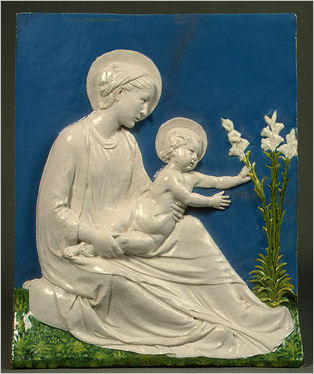 The story of the Della Robbia family begins in 1441-2 when Luca della Robbia, a cultivated and bright minded man, developed a new technique that would allow him to blend the magic of painting, sculpting and pottery making into a brand new form of artistry: the Architectural Ceramic Art.
The story of the Della Robbia family begins in 1441-2 when Luca della Robbia, a cultivated and bright minded man, developed a new technique that would allow him to blend the magic of painting, sculpting and pottery making into a brand new form of artistry: the Architectural Ceramic Art.
His family was very well known in Florence for their textile business, which is somehow connected with the origin of their name: Della Robbia comes from Rubia (madder), a plant used in ancient times as a vegetable red dye for textile dyeing and for painting.
His education as an artist began in a jeweler’s studio and continued in the building site of the Cathedral church of Florence, where he must have met Masaccio, Ghiberti, Donatello and Brunelleschi.  He was commissioned a monumental marble sculpture, the Cantoria (Singing Gallery), showing children who praise the Lord with songs, dance and music. The figures were lively, finely shaped and gracefully combined in groups. The work won him the praise of Brunelleschi and granted him more commissions for the church and the bell tower.
He was commissioned a monumental marble sculpture, the Cantoria (Singing Gallery), showing children who praise the Lord with songs, dance and music. The figures were lively, finely shaped and gracefully combined in groups. The work won him the praise of Brunelleschi and granted him more commissions for the church and the bell tower.
He was considered one of the leaders of the modern style (i.e. the Renaissance style), comparable to Donatello and Ghiberti in sculpture and Masaccio in painting.
In the following years Luca started his experiments with glazed terracotta. When he found the formula, the pliant clay covered with a “slip” of vitrified lead became his favorite medium. With it his reliefs achieved a perfection never before or since attained.
The new technique was beautifully appropriate for architectural sculpture and its success allowed Luca and his family to dominate the cultural and artistic scene for over a century.
Luca’s first architectural sculptures were so successful that he was immediately commissioned two large reliefs for the Cathedral of Florence, the Resurrection (1445) and the Ascension of Christ (1446), and the sculpture Visitazione for the church of San John in Pistoia (1445).
first architectural sculptures were so successful that he was immediately commissioned two large reliefs for the Cathedral of Florence, the Resurrection (1445) and the Ascension of Christ (1446), and the sculpture Visitazione for the church of San John in Pistoia (1445).
He favored the white figures on a blue background, like his famous Madonna of the Apple (1460), the Madonna of Roses (1455), the Madonna and Child (1460), all hosted at the Museo del Bargello in Florence.
Luca was one of Piero de Medici’s favorite artists, as reported by Giorgio Vasari,  who wrote: “the great Piero di Cosimo di Medici, who was among the first to have Luca make things in coloured terracotta, commissioned him, for the study in the palace built by his father Cosimo, to make a barrel vault, with various fantasies, and to treat the floor similarly”. Luca decorated the vaulted ceiling with the celebrated cycle of the Labours of the Months, now at the Victoria & Albert Museum in London (new Medieval and Renaissance galleries due to open in 2009). The floor is unfortunately lost.
who wrote: “the great Piero di Cosimo di Medici, who was among the first to have Luca make things in coloured terracotta, commissioned him, for the study in the palace built by his father Cosimo, to make a barrel vault, with various fantasies, and to treat the floor similarly”. Luca decorated the vaulted ceiling with the celebrated cycle of the Labours of the Months, now at the Victoria & Albert Museum in London (new Medieval and Renaissance galleries due to open in 2009). The floor is unfortunately lost.
Similarly Piero de Medici paid for the vaulting of the chapel of San Miniato al Monte.
Churches, chapels, tombs, noble dwellings were decorated with his medallions, festoons, statues and reliefs, always so rich of light and shadows that one would think it impossible to obtain such results from clay and fire.
The fame of Luca’s works spread all over Europe and to such an extent that the Florentine merchants kept him constantly occupied to his and his family advantage.
In 1448 his brother Simone died and Luca adopted his children, included Andrea, who had already started to work in his uncle’s bottega and would later continue the family activity on a larger scale.
Never tired of experimenting, shortly before his death he began to work on flat clay surfaces, decorating them with scenes and paintings.
He died in Florence in 1482, leaving Andrea, the most talented among his nephews, to continue his activity.
